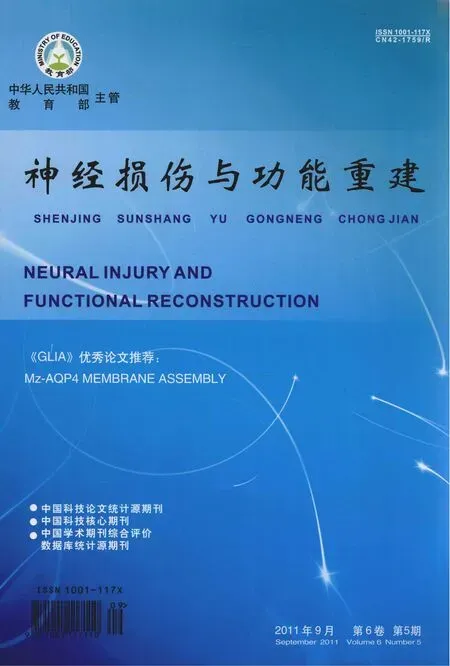缺血性脑卒中的基因背景研究
丁凤菲,王伟
1.华中科技大学同济医学院第二临床学院,武汉430030;2.华中科技大学同济医学院附属同济医院神经内科,武汉430030
脑卒中是世界上仅次于心脏病与癌症的第三大杀手,其中缺血性脑卒中(ischemic stroke)占80%[1]。脑卒中的危险因素多种多样,非获得性危险因素有年龄、种族、性别等,获得性危险因素有高血压、吸烟、房颤、肥胖等[2],但这些因素并不足以完全解释脑卒中的易感性。
在动物模型与临床研究中,研究人员都发现了脑卒中的基因易感性。一项对家系、同胞之间的缺血性脑卒中的研究发现,小部分脑卒中是单基因导致疾病[3]。但研究者更倾向于认为脑卒中是一种多基因、多因子疾病[4]。为寻找与定位脑卒中易感基因,研究者们首先假设一个或多个基因为致病候选基因,再对其进行深入研究,即候选基因(candidate gene)与候选路径(candidate pathway)研究[5]。随着基因分型与基因测序技术的发展,全基因组关联研究(genome-wide association study,GWAS)逐渐被广泛运用,它是经典的病例-对照研究的延伸,通过分析病例组与对照组之间单核苷酸多态性(single-nucleotide polymorphisms,SNPs)的差异,探索脑卒中的基因相关性[6,7]。若能精准定位易感基因,将对预防和治疗疾病有重要意义。但目前的研究仍有一定距离[2]。
1 脑卒中的流行病学研究
基于双胞胎、同胞及家族的研究发现,遗传因素在脑卒中发生中有着重要作用,但其危险程度尚不能确定。研究表明,同卵双生双胞胎的脑卒中一致发病率比异卵双生双胞胎高65%。有脑卒中家族史的人群中,发生缺血性脑卒中的危险度比无家族史的人群高75%。基因易感性依年龄和脑卒中类型的不同而有所差异[8]。Jood等[9]的双胞胎与家系研究表明,70岁之前发生脑卒中的患者中,基因因素所占比重多于年老发病者。
2 与脑卒中相关的单基因遗传病研究
临床研究发现,由单基因遗传疾病引发的缺血性卒中约占1%。缺血性卒中可作为单基因遗传病突出的临床表现,也可伴随有全身系统的症状出现,大多数单基因疾病都与特定卒中亚型相关[10]。累及大动脉的常见单基因遗传病有Moyamoya病,Kamada等[11]的研究认为RNF213为第一个可能的致病基因。累及小血管的单基因遗传病有伴皮质下梗死和脑白质病的常染色体显性遗传性脑动脉病(cerebral autosomal dominant arteriopathy with subcortical infarcts and leukoencephalopathy,CADASIL),由 NOTCH3基因突变造成[12]。继CADASIL后,研究又发现常染色体隐性遗传动脉病变并皮质下梗死与脑白质病(cerebral autosomal recessive arteriopathy with subcortical infarcts and leukoencephalopathy,CARASIL),由 HT RA1 基因突变造成[13]。最新研究发现,编码胶原纤维IV α 1链的COL4A1基因也是致病的单基因突变位点[14]。法布里病(Fabry's disease)是α-半乳糖苷酶(α-galactosidase,α-GLA)基因突变的X 染色体连锁单基因遗传病,既有大血管病变又有小血管病变[15]。马凡综合症(Marfan's syndrome)由FBN1基因外显子突变造成,病变累及心脏与弹性动脉,与心源性脑卒中密切相关[16]。另外,镰形细胞(贫血)症(sickle-cell disease)是导致儿童中风最常见的疾病。研究发现了12个基因中的31个SNPs,其中包括炎症相关基因 P-selectin以及转化生长因子(transforming grow th factor,TGF)-β途径的一些基因,与镰形细胞(贫血)症的脑卒中发生有联系[17]。此外,其它单基因遗传病有高胱氨酸尿症(homocystinuria),线粒体脑肌病、乳酸酸中毒和中风样发作综合征(mitochondria encephalomyopathy lacticacidosis and stroke like episodes,MELAS),Ehlers-Danlos综合征等[18]。
3 多基因、多因子所致脑卒中的基因研究
3.1 候选路径和候选基因研究 虽然已发现许多单基因遗传病与脑卒中密切相关,但大多数脑卒中仍然被认为是多基因源性的[18]。为寻找与定位脑卒中易感基因,人们首先在涉及炎症、脂质代谢、凝血与止血机制、肾素-血管紧张素-醛固酮系统(renin-angiotensin-aldosterone system,RAAS)等路径中选出可能与缺血性脑卒中发生相关的基因,假设其为致病候选基因,再对其进行深入研究,分析候选基因与脑卒中之间的关联。Meta分析对相关性研究进行了总结分析,结果显示,与缺血性脑卒中具有显著相关性的基因及其变异主要有:Gln506基因(编码V Leiden因子),C677T基因(编码MTHFR),G20210A基因(编码促凝素),ACE基因I/D变异,PAI-1 5G以及糖蛋白IIIa基因 Leu33Pro多态性,β-Fg基因455A/G、148T/C多态性,ApoE基因 ε 2/ε 3/ε 4 多态性等[19,20]。
3.2 同型半胱氨酸代谢途径 5,10-亚甲基四氢叶酸还原酶(5,10-methylenetetrahydrofolate reductase,MT HFR)是同型半胱氨酸(homocysteine,Hcy)代谢中一种关键酶,其编码基因C677T的变异,能升高血浆中Hcy浓度,从而提高脑卒中发生的危险性,与小血管病变性脑卒中的发生密切相关。T T基因型存在于10%的人群中,可使血浆中Hcy升高20%左右。Meta分析显示,TT基因型发生缺血性脑卒中的危险性明显高于CC基因型[21]。
3.3 RAAS 最早发现的是血管紧张素转换酶(angiotensin converting enzyme,ACE)编码基因的插入/缺失变异,DD基因型携带者的平均ACE活性浓度是II基因型携带者的近2倍,具有更高的缺血脑卒中的发生风险[22]。Rubattu等[23]报道血管紧张素Ⅱ受体的A1166C基因变异能增加患者的缺血性脑卒中的发病风险,尤其对于原发性高血压病患者。Munshi等[24]的病例对照研究提示,人类醛固酮合成酶基因(CYP11B2)启动子区的变异-344C/T(rs179998)与缺血性脑卒中的发生有密切关系。针对中国汉族人的Meta分析证实了这一观
点[25]。
3.4 凝血与止血系统 研究发现,与高凝状态相关的V Leiden因子基因的Arg506Gln变异,凝血素基因的G20210A变异,以及纤溶酶原激活物抑制剂1(plasminogen activator inhibitor 1,PAI1)基因的启动子4G/5G多态性能提高缺血性脑卒中的发生风险[26]。另外,Maguire等[27]认为血小板糖蛋白1bα(glycoprotein1bα,GP1bα)基因的 Thr/Met变异在显性遗传模式中与缺血性脑卒中相关。组织因子(tissue factor,TF)基因的SNP rs1324214(C/T)及单体型H3与配对单倍体H3变异被认为与意大利和德国青少年人群缺血性脑卒中的发生有显著性关联[28]。
3.5 脂质代谢 对氧磷酶(paraoxonase,PON)1基因编码位于高密度脂蛋白(high-density lipoprotein,HDL),PON1基因的rs662((p.Q192R)多态性被认为与缺血性脑卒中的发生有一定相关性,且在白种人中关联较为显著,在东亚人种中关联不显著[29]。ApoE 基因 ε 2/ε 3/ε 4 多态性与缺血性脑卒中的发生密切相关。其中ApoE基因ε 3/3基因型在亚洲人群中最为常见[30],而与中国北方汉族人缺血性脑卒中发病显著相关的是ApoE基因ε 2/ε 4多态性[31]。
3.6 磷酸二酯酶 4D(phosphodiesterase 4D,PDE4D)PDE 4D能降解第二信使环磷酸腺苷(cyclic adenosine monophosphate,cAMP),与血管内皮细胞、平滑肌细胞及炎症细胞关系密切。通过全基因组连锁分析(genome-wide linkage analysis),PDE 4D的编码基因定位于5q12(STRK1区)。对冰岛人群研究中,该基因被认为与缺血性脑卒中的发生密切相关。PDE 4D编码基因的 260个SNPs被检测,其中6个与脑卒中有关联[32]。针对报道的SNPs,许多后续研究在不同人群进行验证。Anjana等[33]发现南印度人群中,SNPs83(rs966221)与大小动脉型缺血性脑卒中有显著关联。Xu等[34]发现亚洲人群中,SNPs 83 C等位基因与SNPs 83 CC基因型和缺血性脑卒中最有关联。
3.7 ALOX5AP基因与白三烯路径 ALOX5AP
基因编码的脂氧化酶活化蛋白(lipoxygenase activating protein,FLAP)是白三烯途径中的重要物质。在冰岛人群中,ALOX5AP的一个单体型(HapA)变异可使脑卒中危险度增加 1.8倍[35]。ALOX5AP基因的SNP变异SG13S114在伊比利亚人群中,能调控ALOX5AP的表达水平,是缺血性脑卒中的独立性危险因素[36]。
3.8 其它候选路径和候选基因 除此之外,还有许多关于其它一些候选基因和路径与缺血性脑卒中关系的研究。但大多数研究无阳性结果,或者不能被后续的研究所重复[2]。
4 全基因组关联分析(genome wide association studies,GWAS)
随着DNA测序技术的发展,科学家们可更快、更经济地获得大样本、高通量的基因信息。GWAS就是以此为原料,运用生物信息学研究方法,比对患者与正常对照者的基因信息,寻找复杂疾病相关的易感基因。最常以人类基因组中的SNPs为标签,运用基因芯片技术,进行大规模的SNPs分型。与候选基因关联分析策略明显不同的是,GWAS不需要在研究之前构建任何假设,即假设某些特定的基因或位点与疾病相关联[6]。
现有的关于缺血性脑卒中的GWAS数量并不多。Matarin等[7]最先进行缺血性脑卒中的GWAS,以249名北美白人缺血性脑卒中患者为对象,筛选出几百个有一定相关性的SNPs,相关性显著的一些SNPs位于候选基因中或与之邻近。虽然结果的变异性较大,但这一结果为后续的GWAS奠定了基础。
研究显示,大多数筛选出的SNPs与缺血性脑卒中发生的关联较弱,或者其关联性仅局限于特定人群或脑卒中的特定亚型。Hata等[37]以日本Hisayama地区的1112名患者为研究对象,进行GWAS发现,PRKCH基因(编码 PKCη)中的 SNP(1425 G/A)与腔隙性脑梗死显著性相关。随后运用2个独立的队列研究进行了验证。Ikram等[38]的GWAS发现,定位于染色体12p13,邻近NINJ2基因(编码胶质细胞粘附分子)与WNK1基因(编码丝/苏氨酸激酶)的 2个SNPs(SNPs rs11833579与rs12425791)在大样本的黑人人群和荷兰人群研究中,与脑卒中有显著性关联,并且在荷兰人群中,与动脉血栓性脑卒中亚型关联性更加显著。然而,SNP rs12425791在瑞典人群中并不与缺血性脑卒中相关[39]。另一 GWAS发现,4q25上的SNP rs2200733与rs10033464,与缺血性脑卒中有显著性关联,这结论在2个欧洲人群中得到验证[40]。另有研究显示,位于9p21的CDKN2A与CDKN2B两个候选基因邻近区域的 SNP rs10757274与rs2383206,是缺血性脑卒中的危险变异[41]。Anderson等[42]报 道了 9p21的另 2个 SNPs,rs1537378与rs10757278,与缺血性脑卒中显著相关,且对大血管性脑卒中影响更大。Cheong等[43]发现AdipoQ基因的6个SNPs与韩国人群缺血性脑卒中危险性有关。Xu等[44]发现位于1p32上的SNP rs11206510与缺血性脑卒中有显著性联系。Yamada等[45]在日本人群中开展的GWAS发现,CELSR1基因的SNP rs4044210与rs6007897与缺血性脑卒中的发生相关性有统计学意义,从而推断CELSR1是缺血性脑卒中的可疑致病基因。Ding等[46]对之前Matarin等筛选出的与缺血性脑卒中可能相关的27个变异进行关联分析,结果提示SNP rs11052413、rs1048677、ZNF 650 rs10204475在中国汉族人中与缺血性脑卒中的发生密切相关,其中关联最显著的是SNP rs11052413。
目前,GWAS研究已成为复杂疾病基因研究的热点,但同时也带来许多问题。比如,耗资巨大的研究筛选出的变异相关性不稳定,所有报道的可疑位点都只能解释疾病的一小部分。同时,如果单个变异对缺血性脑卒中发生的影响力较小,其关联性容易被误差掩盖。分析可能的原因是,存在一些目前的GWAS不能识别稀有变异,存在无法检测到的罕见的结构变异或表观遗传变异,存在难以检测到的基因与基因之间和基因与环境之间的相互作用[6]。
5 现状与展望
当下,尚无以中国人群为对象的缺血性脑卒中的GWAS。目前的研究主要是根据其它群体的GWAS筛选出的基因多态性,在中国人群中验证其疾病相关性,并有许多研究者用Meta分析进行总结。另外,也有研究着力于验证候选基因和候选路径与中国人脑卒中发生之间的关系。然而,很少有研究挖掘出新的、有意义的基因变异。
中国的脑卒中发病率位于世界榜首,且疾病将带来沉重的经济与社会负担。脑卒中的基因背景研究能为疾病预防与治疗研究提供突破口,为实现个体化治疗奠定基础。同时,中国人群基数大,发病率高,研究成本相对低廉等特点,都有利于开展大规模中国人群基因背景研究。
随着基因测序技术与生物信息学技术的发展,脑卒中的基因背景研究将运用全基因组测序技术、外显子测序技术、RNA测序技术、表观遗传学研究方法,结合计算机软件技术、统计学方法学,研究复杂疾病的发生发展机制,具有光明的临床运用前景。
[1]Goldstein LB,Adams R,Alberts MJ,et al.Primary prevention of ischemic stroke:a guideline from the A-merican Heart Association/American Stroke Association Stroke Council[J].Stroke,2006,37(6):1583-1633.
[2]Dichgans M.Genetics of ischaemic stroke[J].Lancet Neurol,2007,6(2):149-161.
[3]Hassan A,Markus HS.Genetics and ischaemic stroke[J].Brain,2000,123(Pt 9):1784-1812.
[4]Tonk M,Haan J.A review of genetic causes of ischemic and hemorrhagic stroke[J].J Neurol Sci,2007,257(1-2):273-279.
[5]M unshi A,Kaul S.Genetic basis of stroke:An overview[J].Neurol India,2010,58(2):185-190.
[6]Manolio TA.Genomewide association studies and assessment of the risk of disease[J].N Engl J Med,2010,363(2):166-176.
[7]M atarin M,Brown WM,Scholz S,et al.A genomewide genotyping study in patients with ischaemic stroke:initial analysis and data release[J].Lancet Neurol,2007,6(5):414-420.
[8]Flossmann E,Schulz UG,Rothwell PM.Systematic review of methods and results of studies of the genetic epidemiology of ischemic stroke[J].Stroke,2004,35(1):212-227.
[9]Jood K,Ladenvall C,Rosengren A,et al.Family history in ischemic stroke before 70 years of age:the Sahlgrenska Academy Study on Ischemic Stroke[J].Stroke,2005,36(7):1383-1387.
[10]Razvi SS,Bone I.Single gene disorders causing ischemic stroke[J].J Neurol,2006,253(6):685-700.
[11]Kamada F,Aoki Y,Narisawa A,et al.A genomewide association study identifies RNF213 as the first Moyamoya disease gene[J].J Hum Genet,2011,56(1):34-40.
[12]Opherk C,Peters N,Holtmannspö tter M,et al.Heritability of M RI lesion volume in CADASIL:evidence for genetic modifiers[J].Stroke,2006,37(11):2684-2689.
[13]Fukutake T.Cerebral autosomal recessive arteriopathy with subcorticalinfarcts and leukoencephalopathy(CARASIL):from discovery to gene identification[J].J Stroke Cerebrovasc Dis,2011,20(2):85-93.
[14]Lanfranconi S,Markus HS.COL4A1 mutations as a monogenic cause of cerebral small vessel disease:a systematic review[J].Stroke,2010,41(8):e513-518.
[15]Rolfs A,Bö ttcher T,Zschiesche M,et al.Prevalence of Fabry disease in patients with cryptogenic stroke:a prospective study[J].Lancet,2005,366(9499):1794-1796.
[16]Judge DP,Dietz HC.Marfan's syndrome[J].Lancet,2005,366(9501):1965-1976.
[17]Switzer JA,Hess DC,Nichols FT,et al.Pathophysiology and treatment of stroke in sickle-cell disease:present and future[J].Lancet Neurol,2006,5(6):501-512.
[18]Matarin M,Singleton A,Hardy J,et al.The genetics of ischaemic stroke[J].J Intern Med,2010,267(2):139-155.
[19]Bentley P,Peck G,Smeeth L,et al.Causal relationship of susceptibility genes to ischemic stroke:comparison to ischemic heart disease and biochemical determinants[J].PLoS One,2010,5(2):e9136.
[20]Xu X,Li J,Sheng W,et al.Meta-analysis of genetic studies from journals published in China of ischemic stroke in the Han Chinese population[J].Cerebrovasc Dis,2008,26(1):48-62.
[21]Kawamoto R,Kohara K,Oka Y,et al.An association of 5,10-methylenetetrahydrofolate reductase(MT HFR)gene polymorphism and ischemic stroke[J].J Stroke Cerebrovasc Dis,2005,14(2):67-74.
[22]Sayed-Tabatabaei FA,Oostra BA,Isaacs A,et al.ACE polymorphisms[J].Circ Res,2006,98(9):1123-1133.
[23]Rubattu S,Di Angelantonio E,Stanzione R,et al.Gene polymorphisms of the rennin-angiotension-aldosterone system and the risk of ischemic stroke:a role of the A1166C/A T1 gene variant[J].J Hypertens,2004,22(11):2129-2134.
[24]M unshi A,Sharma V,Kaul S,et al.Association of the-344C/T aldosterone synthase(CYP11B2)gene variant with hypertension and stroke[J].J Neurol Sci,2010,296(1-2):34-38.
[25]Tu Y,Cui G,Xu Y,et al.Genetic polymorphism of CYP11B2 gene and stroke intheHan Chinese popula-tion and a meta-analysis[J].Pharmacogenet Genomics,2011,21(3):115-120.
[26]Casas JP,Hingorani AD,Bautista LE,et al.Metaanalysis of genetic studies in ischemic stroke:thirtytwo genes involving approximately 18,000 cases and 58,000 controls[J].Arch Neurol,2004,61(11):1652-1661.
[27]Maguire JM,Thakkinstian A,Sturm J,et al.Polymorphisms in platelet glycoprotein 1balpha and factorⅦand risk of ischemic stroke:a meta-analysis[J].Stroke,2008,39(6):1710-1706.
[28]DE Gaetano M,Quacquaruccio G,Pezzini A,et al.Tissue factor gene polymorphisms and haplotypes and the risk of ischemic vascular events:four studies and a meta-analysis[J].J Thromb Haemost,2009,7(9):1465-1471.
[29]Banerjee I.Relationship between Paraoxonase 1(PON1)gene polymorphisms and susceptibility of stroke:a meta-analysis[J].Eur J Epidemiol,2010,25(7):449-458.
[30]Tamam Y,Tasdemir N,Toprak R,et al.Apolipoprotein E genotype in patients with cerebrovascular diseases and its effect on the disease outcome[J].Int J Neurosci,2009,119(7):919-935.
[31]Wang B,Zhao H,Zhou L,et al.Association of genetic variation in apolipoprotein E and low density lipoprotein receptor with ischemic stroke in Northern Han Chinese[J].J Neurol Sci,2009,276(1-2):118-122.
[32]Gretarsdottir S,Thorleifsson G,Reynisdottir ST,et al.The gene encoding phosphodiesterase 4D confers risk of ischemic stroke[J].Nat Genet,2003,35(2):131-138.
[33]Munshi A,Babu MS,Kaul S,et al.Phosphodiesterase 4D(PDE4D)gene variants and the risk of ischemic stroke in a South Indian population[J].J Neurol Sci,2009,285(1-2):142-145.
[34]Xu X,Li X,Li J,et al.Meta-analysis of association between variation in the PDE4D gene and ischemic cerebral infarction risk in Asian populations[J].Neurogenetics,2010,11(3):327-333.
[35]Helgadottir A,Manolescu A,Thorleifsson G,et al.The gene encoding 5-lipoxygenase activating protein confers risk of myocardial infarction and stroke[J].Nat Genet,2004,36(3):233-239.
[36]Domingues-Montanari S,Fernández-Cadenas I,del Rio-Espinola A,et al.Association of a genetic variant in the ALOX5AP with higher risk of ischemic stroke:a case-control,meta-analysis and functional study[J].Cerebrovasc Dis,2010,29(6):528-537.
[37]Kubo M,Hata J,Ninomiya T,et al.A nonsynonymous SNP in PRKCH(protein kinase C eta)increases the risk of cerebral infarction[J].Nat Genet,2007,39(2):212-217.
[38]Ikram MA,Seshadri S,Bis JC,et al.Genome wide association studies of stroke[J].N Engl J Med,2009,360(17):1718-1728.
[39]Olsson S,Melander O,Jood K,et al.Genetic variant on chromosome 12p13 does not show association to ischemic stroke in 3 Swedish case-control studies[J].Stroke,2011,42(1):214-216.
[40]Gretarsdottir S,Thorleifsson G,Manolescu A,et al.Risk variants for atrial fibrillation on chromosome 4q25 associate with ischemic stroke[J].Ann Neurol,2008,64(4):402-409.
[41]Matarin M,Brown WM,Singleton A,et al.Whole genome analysis suggests ischemic stroke and heart disease share an association with polymorphisms on chromosome 9p21[J].Stroke,2008,39(5):1586-1589.
[42]Anderson CD,Biffi A,Rost NS,et al.Chromosome 9p21 in ischemic stroke:population structure and meta-analysis[J].Stroke,2010,41(6):1123-1131.
[43]Cheong MY,Bang OS,Cha M H,et al.Association of the adiponectin gene variations with risk of ischemic stroke in a Korean population[J].Yonsei Med J,2011,52(1):20-25.
[44]Xu C,Wang F,Wang B,et al.Minor allele C of chromosome 1p32 single nucleotide polymorphism rs11206510 confers risk of ischemic stroke in the Chinese Han population[J].Stroke,2010,41(8):1587-1592.
[45]Yamada Y,Fuku N,Tanaka M,et al.Identification of CELSR1 as a susceptibility gene for ischemic stroke in Japanese individuals by a genome-wide association study[J].Atherosclerosis,2009,207(1):144-149.
[46]Xu C,Wang F,Wang B,et al.Confirmation of genome wide association signals in Chinese Han population reveals risk loci for ischemic stroke[J].Stroke,2010,41(1):177-180.

